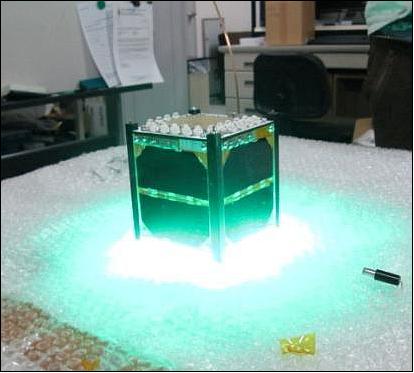The answer is no, a disco light on the ISS isn't visible to a ground-based observer's naked eye.
This is true both for the literal definition of disco light (a light used in a disco around people) and the slang definition (emergency lights on vehicles), trivially by reversing the issue: what kind of lights does an astronaut on the ISS observe from space while looking down at the Earth? The answer isn't individual car headlights or emergency lights, individual ships on the sea, etc etc etc. Remotely-eye-safe lights, without being pointed at the observer, are not going to be visible across a 400km-ish gap (at minimum; the ISS is further away when at the observer's horizon).
Successful observation from the ISS of specific, targeted lights from the ground has been done! In 2012, 800-million-lumen spotlights and a 1-watt laser (eye danger!!) were spotted from the ISS by Don Petit. The results are recorded:

I agree with the article's interpretation: the dim light is from the laser pointer. The bright light is from the 800-million-lumen spotlights. Both are pointed at the space station. The light you're asking for is supposed to be visible to any observer, not just someone an astronaut is tracking with a spotlight. (800 million lumens is slightly more meager than the lights advertised by Northstar Searchlight Promotions, so that tight beam likely requires around a kilowatt of electric power.)
If you want the light to be about as bright as what we currently see from the ISS, the light has to be about as bright (within an order of magnitude) as the sun seen from Earth. The additional path length added by reflection from ISS is negligible compared to the Earth-Sun distance. The reflectivity of the ISS in visible light is reasonably high. That isn't an unachievable level of light, but it would be terribly inconvenient for anyone on or near the ISS.
A quantitative answer to "how bright would the light have to be," the natural follow-on question can be worked out from the maths done by uhoh regarding orbiting billboards by varying the parameters as appropriate.
Funnily enough, the objections others raised about astronomy are basically trivial since you're only asking for the one source on ISS; the issue with Starlinks is that they're bright AND everywhere, and so observing can't be planned around them. Much less of an issue with only one stupidly-bright source. I maintain my objection that the light shouldn't strobe, though, to avoid the need to update the How to Identify that Light in the Sky chart.



